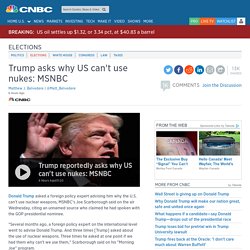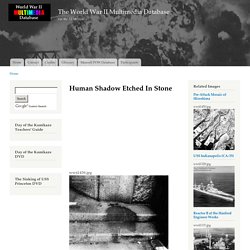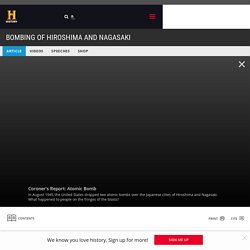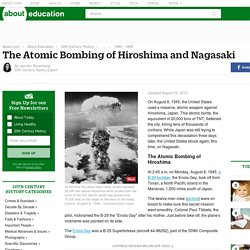

Trump asks why US can't use nukes: MSNBC's Joe Scarborough reports. Donald Trump asked a foreign policy expert advising him why the U.S. can't use nuclear weapons, MSNBC's Joe Scarborough said on the air Wednesday, citing an unnamed source who claimed he had spoken with the GOP presidential nominee.

"Several months ago, a foreign policy expert on the international level went to advise Donald Trump. And three times [Trump] asked about the use of nuclear weapons. Three times he asked at one point if we had them why can't we use them," Scarborough said on his "Morning Joe" program. Scarborough made the Trump comments 52 seconds into an interview with former Director of Central Intelligence and ex-National Security Agency Director Michael Hayden.
Scarborough then asked a hypothetical question to Hayden about how quickly nuclear weapons could be deployed if a president were to give approval. "It's scenario dependent, but the system is designed for speed and decisiveness. Hayden was CIA director from 2006 to 2009 during the George W. The World War II Multimedia Database. Caption: United States Strategic Bombing Survey (USSBS) photo of the steps of Sumitomo Hiroshima Bank, Kamiya-Cho, 850 feet (260 meters) from the hypocenter.

In the flash phase of the bomb, the fireball at the hypocenter reached several million degrees Centigrade and a diameter of 90 feet (28 meters) within one-ten thousandth of a second. One second later, the expanding thermal energy hit the Sumitomo bank with a surface temperature of 9,000 degrees Fahrenheit (5,000 degrees Centigrade). Three seconds after the explosion, the fireball had a surface temperature of 3,100 degrees Fahrenheit (1,700 degrees Centigrade). The fireball ignited every flammable material for over two miles (3.5 kilometers), creating a firestorm that lasted for six hours.
Photographer's Rank or Affiliation: United States Strategic Bombing Copyright Notice: Caption ©2011 MFA Productions LLC Image in the Public Domain. Bombing of Hiroshima and Nagasaki - World War II. Hiroshima, a manufacturing center of some 350,000 people located about 500 miles from Tokyo, was selected as the first target.

After arriving at the U.S. base on the Pacific island of Tinian, the more than 9,000-pound uranium-235 bomb was loaded aboard a modified B-29 bomber christened Enola Gay (after the mother of its pilot, Colonel Paul Tibbets). The plane dropped the bomb–known as “Little Boy”–by parachute at 8:15 in the morning, and it exploded 2,000 feet above Hiroshima in a blast equal to 12-15,000 tons of TNT, destroying five square miles of the city.
Hiroshima’s devastation failed to elicit immediate Japanese surrender, however, and on August 9 Major Charles Sweeney flew another B-29 bomber, Bockscar, from Tinian. The Atomic Bombing of Hiroshima and Nagasaki. Updated August 03, 2015.

On August 6, 1945, the United States used a massive, atomic weapon against Hiroshima, Japan. This atomic bomb, the equivalent of 20,000 tons of TNT, flattened the city, killing tens of thousands of civilians. While Japan was still trying to comprehend this devastation three days later, the United States struck again, this time, on Nagasaki. The Atomic Bombing of Hiroshima At 2:45 a.m. on Monday, August 6, 1945, a B-29 bomber, the Enola Gay, took off from Tinian, a North Pacific island in the Marianas, 1,500 miles south of Japan. The twelve-man crew (picture) were on board to make sure this secret mission went smoothly. The Enola Gay was a B-29 Superfortress (aircraft 44-86292), part of the 509th Composite Group. continue reading below our video Loaded: 0% Progress: 0% In order to carry such a heavy load as an atomic bomb, the Enola Gay was modified: new propellers, stronger engines, and faster opening bomb bay doors.
Hiroshimabomben - ett ämnesövergripande tema (del 1) - Robin Smith. Den 6 augusti är Hiroshimadagen, årsdagen för fällandet av den första av de två atombomber som hittills använts i krig.

Att datumet infaller innan terminen startar bör inte hindra oss från att beröra denna viktiga händelse i undervisningen. Kanske är det särskilt angeläget att vi nu, när det gått över sjuttio år sedan bomberna fälldes och få hibakusha (överlevare) finns kvar i livet och när vi riskerar en ny internationell kapprustning samtidigt som en drummel till presidentkandidat undrar varför USA inte kan använda sina kärnvapen, ser till att vårda berättelsen om Hiroshima så att ”bomben” inte bleknar till en abstraktion, ett spöke från det förflutna.
Här följer en beskrivning av hur jag vill att mina elever arbetar med Hiroshima över gränserna för de ämnen jag undervisar i, svenska och engelska.